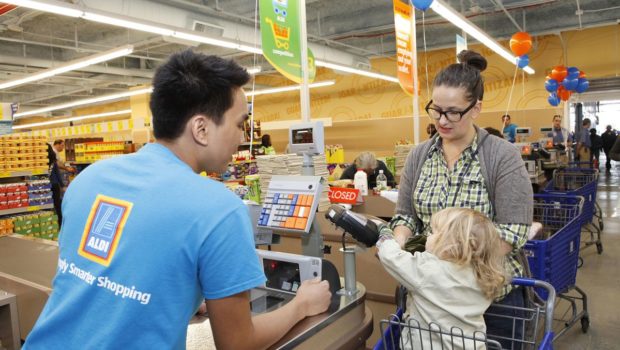Aldi Is Wise To Invest In Amazon Go Style Checkout-Free Technology
Customer enjoys savings of up to 50% on high-quality grocery items at the grand opening of the first ... [+]
Reports surfaced this week that Aldi plans to get into the checkout-free retail technology game. According to ChargedRetail, Aldi has “placed an international call out to tech startups specialising in computer vision and artificial intelligence,” the exact technologies that power Amazon
For the move is likely a matter of strategic life and death.
According to its website, Amazon has roughly 30 Amazon Go stores either in operation or planned to open soon. All deploy Amazon’s “Just Walk Out Technology,” as highlighted in the video below. Here’s how it works: customers simply scan into Amazon Go stores with their mobile phones, just like they are getting on an airplane, take whatever they want off the shelves, and then just walk out the doors and pay electronically, similar to how they would pay for an Uber
While most Amazon Go sites range in size from roughly 1,000 to 3,000 square feet, some of Amazon’s latest efforts, like its Amazon Go Grocery store in Seattle, can get as big as 10,000 square feet and also come stocked with fresh produce.
It is the combination of these last two paragraphs that likely have Aldi on notice.
First, artificial intelligence computer vision (AICV, for short) checkout-free technology is hard to deploy. However, the sooner retailers can implement it, the better off they will be in the long-run because the technology also gets smarter and more efficient the more often that it is used.
AICV is not all that dissimilar from how autonomous cars get trained for the rigors of the road. The underlying technology that drives both is pretty much the same thing. So, while one pilot store is an achievement, Amazon having 30 pilot stores is like giving Usain Bolt a massive head start in the 100 meter dash because Amazon’s system is already training itself to handle many different driving conditions. These conditions could include everything from localized skus, lighting variances, fixture positioning, or even the number of people and products in a store at any given time.
In essence, the more Go stores Amazon has in operation, the smarter the Go system becomes.
Second, a 10,000 square foot grocery store gets awfully darn close to Aldi’s overall operational ethos and operating size. According to Aldi’s own website, Aldi’s U.S. footprints start at 17,000 square feet, and Aldi’s operating model is one of spartan-like efficiency. It is no frills shopping — just get in quickly, efficiently, and as cost effectively as possible from a consumer standpoint.
Amazon Go Grocery is not that far off Aldi’s design in principle, either.
For instance, square footage-wise, Amazon Go technology is probably just a few month-long or year-long Red Bull binges of hard core engineering work away from being ready for 17,000 square feet. Moreover, Amazon Go’s “Just Walk Out Technology” is designed to remove many of the same costs and friction points that Aldi’s model attacks with aplomb. Similar to Aldi, Amazon Go is also about making things easy, so easy, in fact, that it doesn’t even require cashiers or checklanes as part of its overall operating foundation in many states.
In essence, Amazon has the potential to do everything that Aldi can do, only better.
The other scary point is that Aldi has been on quite the growth trajectory of late within the United States. It has been rapidly growing market share within grocery. Its annual U.S. retail volume stands at $31 billion, above both Dollar General
All of which smells like the now famous line Jeff Bezos once uttered — “Your margin is my opportunity.”
To Amazon, Aldi’s outsized market share growth and expansion plans must smell like chum in the water. Or, said another way, Aldi is Chrissie Watkins at the beginning of Jaws and Amazon is the great white shark. Even Amazon’s rumored Amazon Go expansion plans of 3,000 stores by 2021 is oddly close to Aldi’s stated growth plans, regardless of whether Amazon hits its own rumored timelines or not.
Coincidence? Maybe, but maybe not.
Regardless, it is reasonable to think that Amazon likely knows it has something in Amazon Go. Amazon Go can do everything Aldi does, only better, and in a way that doesn’t require that customers stand in line at checklanes and that also has the underpinnings of Amazon Prime, speedy delivery, and its estimated 100 million plus user base already behind it.
Plus, attacking Aldi’s recent success is also a heck of a lot easier for Amazon than trying to compete head-to-head with full-size grocery stores, and Amazon just might even steal some additional share or bring down a few convenience and drug store chains in the process. There could be as much as $30 billion plus in annual sales revenue sitting on the table for the taking before Amazon even ventures into Walmart
While an Amazon spokesperson declined to comment on any of the above speculation, if only a kernel of it is true, what that kernel says is powerful.
As smart as it is for Aldi to go after cashierless technology, Aldi really does not have any other option at this point. Amazon could very well have Aldi’s entire U.S. business model or more within its sights, and the only real question that remains is whether or not Aldi’s effort may be too little, too late.








Gloss